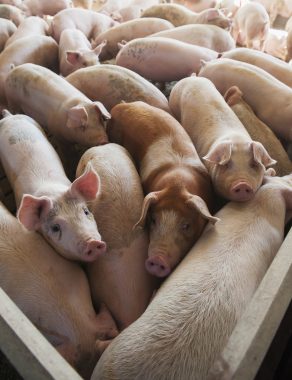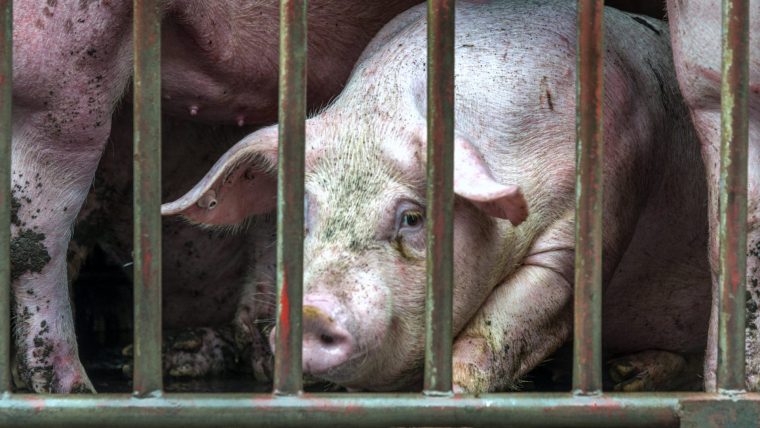
The Federal Swine Health Protection Act
The practice of feeding garbage to swine dates back to the Middle Ages in Europe, and the very beginnings of history in the U.S. Typically, this garbage consisted of what we now call table scraps — including meat. The practice went unregulated for centuries before agriculturalists understood the tie between garbage feeding and outbreaks of “numerous infectious or communicable diseases to swine, including exotic animal diseases such as foot-and-mouth disease, African swine fever, and classical swine fever.”
 But it wasn’t until October 10, 1980, that the federal Swine Health Protection Act (SHPA)1 was passed to “protect the nation’s $7 billion hog industry from the potentially devastating effects of an invasion of African swine fever,”2 via the feeding of garbage to swine.3 The United States Department of Agriculture (USDA) testified to the House of Representatives on the by-then well-known fact that infectious and communicable diseases spread rapidly if untreated or improperly treated garbage is fed to swine. Congress passed the SHPA to provide a “uniform system for the treatment and feeding of garbage fed to swine, with appropriate civil and criminal sanctions for violators.”4
But it wasn’t until October 10, 1980, that the federal Swine Health Protection Act (SHPA)1 was passed to “protect the nation’s $7 billion hog industry from the potentially devastating effects of an invasion of African swine fever,”2 via the feeding of garbage to swine.3 The United States Department of Agriculture (USDA) testified to the House of Representatives on the by-then well-known fact that infectious and communicable diseases spread rapidly if untreated or improperly treated garbage is fed to swine. Congress passed the SHPA to provide a “uniform system for the treatment and feeding of garbage fed to swine, with appropriate civil and criminal sanctions for violators.”4
The SHPA requires existing state garbage feeding programs5 to meet the minimum federal standards to ensure effective enforcement of garbage treatment and feeding.6 The SHPA prohibits the feeding of garbage to swine unless the garbage is treated to kill diseases, and garbage can only be treated at a facility operated by an individual with a permit from the Secretary of Agriculture or the relevant state authority.7 Garbage is defined at the federal level as
[A]ll waste material derived in whole or in part from the meat of any animal (including fish and poultry) or other animal material, and other refuse of any character whatsoever that has been associated with any such material, resulting from the handling, preparation, cooking, or consumption of food, except that such term shall not include waste from ordinary household operations which is fed directly to swine on the same premises where such household is located.”8
Regulations decreed under the SHPA9 require garbage to be “heated throughout at boiling (212° F. or 100° C. at sea level) for 30 (thirty) minutes”10 and agitated to ensure cooking temperature is maintained.11 The regulations also state that the USDA Animal and Plant Health Inspection Service (APHIS) “will maintain” a list of the states that ban or permit garbage feeding on their website,12 but APHIS has not updated the website with this information since April 2020.13

State Swine Garbage Feeding Programs – Diversions from the Federal Government
State programs typically follow the definitions and procedures outlined in the federal framework for feeding swine garbage.14 There are, however, notable differences between federal and state frameworks for what constitutes “garbage.”
States vary in what materials are included as “garbage.” In 24 states, “garbage” includes animal carcasses or parts of carcasses.15 Swine and their carcasses, as an animal, could fall under “animal carcasses,” but Delaware is the only state that prohibits the feeding of garbage to hogs and includes swine carcasses and carcass parts as “garbage.”16 Certain states specify that animal waste for “garbage” purposes includes fish, seafood, poultry, and/or fowl.17 Eight states18 also include animal offal as garbage,19 which is typically “any of [the] various non-muscular parts of the carcasses of beef and veal, mutton and lamb, and pork, which are either consumed directly as food or used in the production of other foods.”20 Florida and Georgia include “swill” as garbage,21 which is typically liquid “food waste containing meat or any other mammalian products or by-products, excluding milk.”22 Swill is banned from being fed to pigs in Australia and the European Union.23
States also exclude materials as “garbage.” Illinois excludes the “contents of the bovine digestive tract” as garbage.24 Garbage may not include bakery or dairy/milk waste.25 Some states have slaughterhouse waste that goes directly to rendering plants as an exception to garbage.26
There are also miscellaneous provisions in state garbage feeding frameworks that are not included in the federal counterpart. In Maryland, the garbage feeding program states that discharged animal feces could be included as hog feed if the final feed product complies with the Food and Drug Administration’s standards.27 Mississippi and Texas ban all feeding of “garbage”28 (or “restricted garbage” in Texas29), but the state’s Department of Corrections/Criminal Justice can feed swine treated garbage.30 Rhode Island’s garbage feeding program only applies if an individual tries to feed garbage to four or more swine.31
Enforcement of the SHPA is the responsibility of each individual state, though the USDA has the right to terminate primary enforcement responsibilities if it is found that a state does not have sufficient laws or regulations or is not effectively executing such laws or regulations.
References
- Animal and Plant Health Inspection Service, U.S. Department of Agriculture
- H.R. Rep. 96-1383, at 6 (1980), as reprinted in 1980 U.S.C.C.A.N. 4661, 4662.
- See id.
- Id. at 7.
- Fifteen states at the time of passage prohibit garbage feeding to swine: Alabama, Delaware, Georgia, Idaho, Illinois, Iowa, Louisiana, Maryland, Mississippi, New York, South Carolina, South Dakota, Tennessee, Virginia, and Wisconsin. Id. The House Report recognizes that the remaining states require garbage to be treated before being fed to swine, but these programs vary in enforcement power. Id.
- Id. at 7-8; see also, 7 U.S.C.A. §§ 3808-3809.
- See 7 U.S.C. §§ 3803(a)-(b), 3804(a).
- 7 U.S.C. § 3802(2).
- See generally 9 C.F.R. § 166.1 et seq.
- 9 C.F.R. § 166.7(a).
- 9 C.F.R. § 166.7(b).
- See 9 C.F.R. § 166.15.
- Swine Health Protection – Garbage Feeding, U.S. Dep’t of Agric. (April 2020), https://www.aphis.usda.gov/animal_health/animal_dis_spec/swine/downloads/swine-health-protection-map.pdf.
- List of states’ garbage feeding programs
- See e.g., Ala. Code § 2-15-211(b); Ariz. Rev. Stat. § 3-2661(2); Ark. Code R. § 209.01.12-I(A)(1); Cal. Agric. Code § 10901; Conn. Gen. Stat. § 22-320a(d); Del. Code tit. 3, § 7108; Iowa Code § 163.26; 302 Ky. Admin. Regs. 22:080(3); Md. Code, Agric. § 3-404(a); 330 Mass. Code Regs. 11.01; Mich. Comp. Laws § 287.744(7); Miss. Code Ann. § 69-11-3(c); Mont. Code Ann. § 81-2-501; N.H. Rev. Stat. § 435:32; N.J. Stat. Ann. § 4:5-106.1; N.M. Stat. Ann. § 77-7-16(A); N.Y. Agric. & Mkts. Law § 72-a(2)(a); N.D. Cent. Code § 36-01-22; 4 R.I. Gen. Laws § 4-3-1(2); S.C. Code Ann. § 47-15-10(a); Tex. Agric. Code Ann. § 165.026(h)(1); 2-301 Vt. Code R. § 2-4-301:I; Va. Code Ann. § 3.2-6031; W. Va. Code, § 19-9A-1(a); Wyo. Stat. Ann. § 11-27-101.
- Del. Code tit. 3, § 7108.
- Ala. Code § 2-15-211(b); Ariz. Rev. Stat. Ann. § 3-2661(2); 720 Ill. Comp. Stat. 5/48-7(a); Ind. Code § 15-17-2-34(a)(1)-(2); 302 Ky. Admin. Regs. 22:080(1)(3); Me. Stat. tit. 7§ 1813; Md. Code Ann., Agric. § 3-404(a); 330 Mass. Code Regs. 11.01; Minn. Stat. § 35.73(4); Miss. Code Ann. § 69-11-3(c); Nev. Admin. Code § 571.150(1)-(2); Ohio Rev. Code Ann. § 942.01(B); 3 Pa. Cons. Stat § 2303; Vt. Stat. Ann. tit. 6 § 1671(a)(1).
- New York, Oregon, and Rhode Island discuss offal in their garbage feeding schemes, but offal is categorized separate from garbage. See N.Y. Agric. & Mkts. Law § 72-a(b); Or. Rev. Stat. § 600.010(2); 4 R.I. Gen. Laws § 4-3-13.
- Ark. Code R. § 209.01.12-I(A)(3); Cal. Agric. Code § 10901; 302 Ky. Admin. Regs. 22:080(3); Mich. Comp. Laws § 287.744(7); N.M. Stat. Ann. § 77-7-16(A); N.C. Gen. Stat § 106-405.1; S.C. Code Ann. § 47-15-10(a); Wash. Rev. Code § 16.36.005(10).
- “Offal,” Britannica (Feb. 10, 2023), https://www.britannica.com/topic/offal.
- See Fla. Stat. § 585.01(12); Ga. Code Ann., § 4-4-20.
- “Pig Swill,” Britannica, https://www.thefreedictionary.com/Pig+swill.
- See Feeding your pigs, Farm Biosecurity Program, https://www.farmbiosecurity.com.au/livestock/pigs/feeding-your-pigs/; see also, Could There Be a Return of Pig Swill in the EU?, The Pig Site (March 29, 2016), https://www.thepigsite.com/news/2016/03/could-there-be-a-return-of-pig-swill-in-the-eu-1.
- 720 Ill. Comp. Stat. 5/48-7(a).
- See Ala. Code § 2-15-211(b); Ind. Code § 15-17-2-34(b)(1), (3)-(4); N.D. Cent. Code § 36-01-22; Ohio Rev. Code Ann. § 942.13(A); Or. Rev. Stat. § 600.095(3); Tenn. Code Ann. § 44-2-402(2); Vt. Stat. Ann. tit. 6, § 1671(b)(2).
- See Conn. Gen. Stat. § 22-320a(d); N.J. Stat. Ann. § 4:5-106.1.
- Md. Code Ann. Agric. § 3-404(2).
- See Miss. Code Ann § 69-11-5(1); Tex. Agric. Code Ann. § 165.026(a).
- Compare Tex. Agric. Code Ann. § 165.026(a), with Tex. Agric. Code Ann. § 165.026(c).
- See Miss. Code Ann § 69-11-5(3); Tex. Agric. Code Ann. § 165.026(a).
- 4 R.I. Gen. Laws § 4-3-2.
Related
-
Opposing the Cultivation and Trade of Octopus Produced through Unethical Strategies Act Introduced in the U.S. Senate
The federal bill would prevent the industry from gaining traction by banning commercial octopus farming in the U.S.July 25, 2024 News -
Complaint Demands Endangered Species Act be Enforced Against Washington Sham Animal Sanctuary to Protect Animals
Predators of the Heart, sometimes also known as Because We Matter Exotic Animal Rescue, has threatened to kill endangered wolves if it is not allowed to reopen.July 16, 2024 Press Release -
Lawsuit Filed Against USDA for Issuing Animal Welfare Act License to Serial Violator Yellowstone Bear World
The complaint argues the wildlife park causes undue stress to bear cubs by offering bottle-feeding and photo opportunities to the public as well as separating them from their mothers.July 16, 2024 Press Release



